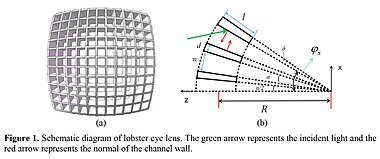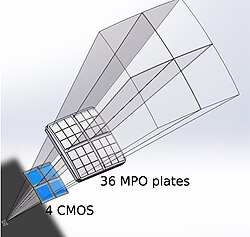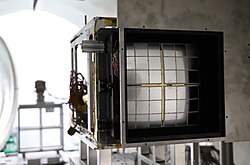Astronomy:Lobster-eye optics

Lobster-eye optics is an X-ray optics design that mimic the structure of the lobster's eyes and has an ultra wide field of view. It was proposed in 1979, and first used in the Chinese technology demonstrator spacecraft Lobster Eye Imager for Astronomy, launched in 2022. First major space telescope that uses lobster-eye optics is Chinese Einstein Probe, launched in 2024. Several other such space telescopes are under development or consideration.
Description

Lobster-eye optics mimic the structure of the crustacean's (lobster's) eyes, that are made up of long, narrow cells that each reflect a tiny amount of light from a given direction. This allows the light from a wide viewing area to be focused into a single image. The optics are made of microchannel plates (or micropores) — thin, curved slabs of material dotted with tiny tubes across the surface. X-ray light can enter these tubes from multiple angles and is focused through grazing-incidence reflection that gives a wide field of view necessary for finding and imaging transient events that cannot be predicted in advance.[2]
The field of view of a lobster-eye optic, which is the solid angle subtended by the optic plate to the curvature center, is limited only by the optic size for a given curvature radius. Since the micropore optics is spherically symmetric in essentially all directions, theoretically, an idealized LE optic is almost free from vignetting except near the edge of the FoV.[3]
History
Only three geometries that use grazing incidence reflection of X-rays to produce X-ray images are known: Wolter system, Kirkpatrick-Baez system, and lobster-eye geometry.[4]
The lobster-eye X-ray optics design was first proposed in the 1979 by Roger Angel.[5][6] His design is based in Kirkpatrick-Baez optics, but requires pores with square cross-section. An alternative arrangement had been proposed by W. K. H. Shmidt in 1975: a one-dimensional arrangement consisting of a set of flat reflecting surfaces.[7][8] In 1989, physicists Keith Nugent and Stephen W. Wilkins collaborated to develop a lobster-eye optics, independently of Angel. Nugent and Wilkins' key contribution was to open up an approach to manufacturing these devices using microchannel plate technology. The lobster-eye approach opened the way for X-ray telescopes with a 360 degree view of the sky.[9] In 1992, Philip E. Kaaret and Phillip Geissbuehler proposed a method "for fabricating such optics using microchannel plates".[10]
Two designs are usually called the "Schmidt focusing collimator objective" and "Angel multi-channel lens".[4]
Micropores required for the lobster-eye optics are very hard to manufacture. Requirements are described in The WSPC Handbook of Astronomical Instrumentation:[4]
The pores must be square with width, 0.01 <d< 0.5 mm, and length L such that L/d is in the range 20–200, depending on the X-ray energy range you hope to cover and the angular resolution you hope to achieve. All the inner walls of the pores must be flat, very smooth with a surface roughness ≤ 1 nm, and made from or coated with a high-Z (dense) material to give a high X-ray reflection efficiency. The pores must be integrated into an array using a simple square, waffle, or similar packing scheme with a wall thickness that gives an open fraction of > 50% so that the optic has a reasonable efficiency. Finally, the pores must be packed on a spherical surface with radius of curvature 2F and with the axis of every pore aligned to point towards the common center of curvature with an accuracy in the range 0.1–5 arc minutes, commensurate with the angular resolution required.
Usage


Lobster-eye optics can be used for backscattering imaging and is used for homeland security, detection of improvised explosive devices, non-destructive testing, and medical imaging.[1]
Technology demonstrators
The Chinese lobster-eye X-ray satellite was successfully launched on 25 July 2020 from the Taiyuan Satellite Launch Center. It was the first in-orbit space exploration satellite equipped with such imaging technology.[11]
Chinese Lobster Eye Imager for Astronomy (LEIA) is a wide-field X-ray imaging space telescope built by Chinese Academy of Sciences (CAS) and launched on July 27, 2022, onboard of SATech-01 satellite. LEIA has a sensor module giving it a field of view of 340 square degrees.[12] In August and September of 2022, LEIA carried out a series of test observations for several days as part of its performance verification phase. A number of preselected sky regions and targets were observed, including the Galactic Center, the Magellanic Clouds, Sco X-1, Cas A, Cygnus Loop, and a few extragalactic sources. The observations were performed in Earth's shadow to eliminate the effects of the Sun, starting 2 minutes after the satellite entering the shadow and ending 10 minutes before leaving it, resulting in an observational duration of ∼23 minutes in each orbit. The CMOS detectors were operating in the event mode.[3] LEIA is a technology demonstration mission testing the sensor design for the Einstein Probe.[12]
First-light X-ray image of the Galactic center region obtained by LEIA in a one-shot observation of 798 s in 0.5–4 keV, covering a field of view of 18fdg6 × 18fdg6 (left). Colors represent counts per pixel.[3]
Left: X-ray image of Sco X-1 in 0.5–4 keV observed by LEIA with 673 s exposure. Right: X-ray image of the Cygnus Loop nebula with a diameter of ∼2fdg5 obtained with a 604 s observation. Colors represent photon energies.[3]
Current and future space telescopes
Einstein Probe, a joint mission by Chinese Academy of Sciences (CAS) in partnership with ESA and the Max Planck Institute for Extraterrestrial Physics (MPE), was launched on 9 January 2024.[13] EP uses a 12 sensor module Wide-field X-ray Telescope for a 3600 square degree field of view, first tested by LEIA mission.[12]
NASA's Goddard Space Center proposed an instrument that uses lobster-eye design for the ISS-TAO mission (Transient Astrophysics Observatory on the International Space Station), called X-ray Wide-Field Imager (WFI).[2]
Several space telescopes that use lobster-eye optics are under construction. Joint French-Chinese SVOM is expected to be launched in July 2024. SMILE, a space telescope project by ESA and the CAS, is planned to be launched in 2025. ESA's THESEUS is now under consideration.
References
- ↑ 1.0 1.1 Ma, Shizhang; Ouyang, Mingzhao; Fu, Yuegang; Hu, Yuan; Zhang, Yuhui; Yang, Yuxiang; Wang, Shengyu (September 2023). "Analysis of Imaging Characteristics of Wide-field Lobster Eye Lens" (in en). Journal of Physics: Conference Series 2597 (1): 012010. doi:10.1088/1742-6596/2597/1/012010. ISSN 1742-6596. Bibcode: 2023JPhCS2597a2010M. https://iopscience.iop.org/article/10.1088/1742-6596/2597/1/012010/meta. Retrieved 29 December 2023.
 Material was copied from this source, which is available under a Creative Commons Attribution 3.0
Material was copied from this source, which is available under a Creative Commons Attribution 3.0
- ↑ 2.0 2.1 "Proposed NASA Mission Employs "Lobster-Eye" Optics to Locate Source of Cosmic Ripples - NASA". NASA. 26 October 2017. https://www.nasa.gov/missions/station/proposed-nasa-mission-employs-lobster-eye-optics-to-locate-source-of-cosmic-ripples/.
 This article incorporates text from this source, which is in the public domain.
This article incorporates text from this source, which is in the public domain.
- ↑ 3.0 3.1 3.2 3.3 3.4 3.5 Zhang, C. et al. (1 December 2022). "First Wide Field-of-view X-Ray Observations by a Lobster-eye Focusing Telescope in Orbit". The Astrophysical Journal Letters 941 (1): L2. doi:10.3847/2041-8213/aca32f. ISSN 2041-8205. Bibcode: 2022ApJ...941L...2Z.
 Material was copied from this source, which is available under a Creative Commons Attribution 4.0
Material was copied from this source, which is available under a Creative Commons Attribution 4.0
- ↑ 4.0 4.1 4.2 Richard Willingale (July 2021). "Lobster Eye Optics". in Sternberg, Amiel; Burrows, David N (in en). The WSPC Handbook of Astronomical Instrumentation: Volume 4: X-Ray Astronomical Instrumentation. World Scientific Publishing Co. Pte. Ltd.. pp. 33-47, 85-106. ISBN 978-981-4644-38-9. https://doi.org/10.1142/9446-vol4. Retrieved 1 January 2024.
- ↑ Angel, J. R. P. (Oct 1, 1979). "Lobster eyes as X-ray telescopes". Astrophysical Journal 233 (Part 1): 364–373. doi:10.1086/157397. Bibcode: 1979ApJ...233..364A. https://adsabs.harvard.edu/full/1979ApJ...233..364A. Retrieved 29 December 2023.
- ↑ Hartline, Beverly Karplus (4 January 1980). "Lobster-Eye X-ray Telescope Envisioned" (in en). Science 207 (4426): 47. doi:10.1126/science.207.4426.47. ISSN 0036-8075. Bibcode: 1980Sci...207...47K. https://www.science.org/doi/10.1126/science.207.4426.47. Retrieved 29 December 2023.
- ↑ Hudec, Rene; Feldman, Charly (2022). "Lobster Eye X-ray Optics" (in en). Handbook of X-ray and Gamma-ray Astrophysics. Springer Nature. pp. 1–39. doi:10.1007/978-981-16-4544-0_3-1. ISBN 978-981-16-4544-0. https://link.springer.com/referenceworkentry/10.1007/978-981-16-4544-0_3-1.
- ↑ Schmidt, W. K. H. (August 1, 1975). "A proposed X-ray focusing device with wide field of view for use in X-ray astronomy". Nuclear Instruments and Methods 127 (2): 285–292. doi:10.1016/0029-554X(75)90501-7. https://www.sciencedirect.com/science/article/pii/0029554X75905017.
- ↑ "Scientist has an all-seeing eye on the future" (in en). 2004-08-19. https://www.theage.com.au/national/scientist-has-an-all-seeing-eye-on-the-future-20040819-gdyhdr.html.
- ↑ Kaaret, Philip E.; Geissbuehler, Phillip (1992). "Lobster-eye x-ray optics using microchannel plates". SPIE Proceedings. doi:10.1117/12.51261. http://dx.doi.org/10.1117/12.51261.
- ↑ "Launch of the world's first soft X-ray satellite with 'Lobster-Eye' imaging technology" (in en). https://phys.org/news/2020-07-world-soft-x-ray-satellite-lobster-eye.html.
- ↑ 12.0 12.1 12.2 "Einstein Probe Time Domain Astronomical Information Center". https://ep.bao.ac.cn/ep/cms/article/view?id=91.
- ↑ "Einstein Probe lifts off on a mission to monitor the X-ray sky". https://www.esa.int/ESA_Multimedia/Images/2024/01/Einstein_Probe_lifts_off_on_a_mission_to_monitor_the_X-ray_sky.
 |



